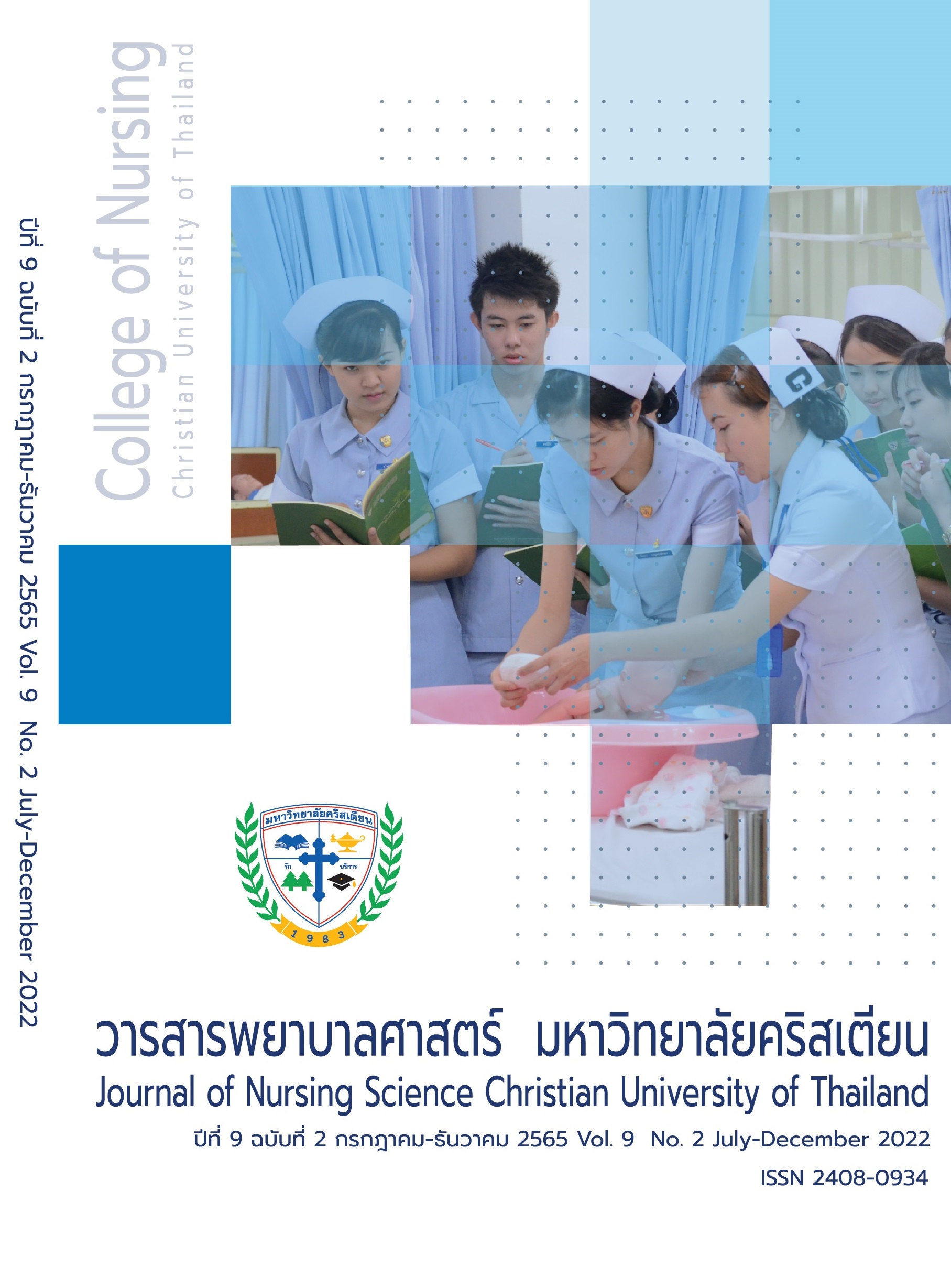การพยาบาลผู้ป่วยที่ติดเชื้อในกระแสเลือดจากการใส่สายสวนหลอดเลือดดำส่วนกลาง :กรณีศึกษาเปรียบเทียบ
คำสำคัญ:
ผู้ป่วยที่ได้รับการรักษาด้วยการใส่สายสวนหลอดเลือดดำส่วนกลาง, การติดเชื้อในกระแสเลือดจากการใส่สายสวนหลอดเลือดดำส่วนกลาง, ภาวะแทรกซ้อนบทคัดย่อ
การติดเชื้อในกระแสเลือดจากการใส่สายสวนหลอดเลือดดำส่วนกลาง เป็นภาวะแทรกซ้อนที่พบบ่อยในผู้ป่วยที่ได้รับการใส่คาสายสวนหลอดเลือดดำส่วนกลาง ซึ่งส่งผลกระทบให้ผู้ป่วยนอนรักษาตัวในโรงพยาบาลนานขึ้น ค่าใช้จ่ายในการดูแลผู้ป่วยสูงขึ้น และเสียชีวิตได้ ดังนั้นพยาบาลผู้ดูแลจะต้องมีการวางแผนในการพยาบาลผู้ป่วยที่ใส่สายสวนหลอดเลือดดำส่วนกลางเพื่อป้องกันการเกิดการติดเชื้อในกระแสเลือด
บทความนี้มีวัตถุประสงค์เพื่อทบทวนกระบวนการพยาบาลในผู้ป่วยกรณีศึกษา 2 รายที่รับไว้ดูแลในหอผู้ป่วยกึ่งวิกฤตจากภาวะติดเชื้อในกระแสเลือดจากโรคติดเชื้อหนองในช่องเยื่อหุ้มปอด และโรคไตเรื้อรังระยะสุดท้าย ที่ได้รับการรักษาด้วยการใส่สายสวนหลอดเลือดดำส่วนกลางและเกิดการติดเชื้อในกระแสเลือด ซึ่งการดูแลที่ผู้ป่วยได้รับการพยาบาลอย่างใกล้ชิด โดยมีการประเมินอาการเปลี่ยนแปลง การดูแลให้ได้รับการรักษาตามแผนการรักษาของแพทย์อย่างครบถ้วน รวมทั้งมีการดูแลตามมาตรการป้องกันการติดเชื้อในกระแสเลือดจากการใส่สายสวนหลอดเลือดดำส่วนกลางของโรงพยาบาลจนผู้ป่วยมีสุขภาพดีขึ้นสามารถจำหน่ายออกจากโรงพยาบาลได้
เอกสารอ้างอิง
นิตยา อินทราวัฒนา และมุทิตา วนาภรณ์. (2558). โรคติดเชื้อในโรงพยาบาลและสถานการณ์การดื้อยา. Journal of Medicine and Health Sciences, 22(1), 81-92.
บูรพา กาญจนบัตร. (2558). การใส่และดูแลสายสวนหลอดเลือด. กรุงเทพมหานคร: โฆษิตการพิมพ์.
ภัทราภรณ์ ศรีพรมมา และดวงกมล สุขทองสา. (2562). การดูแลผู้ป่วยที่ติดเชื้อในกระแสเลือดจากการใส่สายหลอดเลือดดำส่วนกลาง: กรณีศึกษา. วชิรสารการพยาบาล, 21(2), 88-99.
ยาใจ อภิบุณโยภาส. (2557). การใส่สายสวนหลอดเลือดดำส่วนกลาง. ธรรมศาสตร์เวชสาร, 14(1), 79-92.
โรงพยาบาลนครปฐม. (2563). รายงานประจำปี 2558 ถึง 2562. นครปฐม: โรงพยาบาลนครปฐม.
สถาบันบำราศนราดูร กรมควบคุมโรค กระทรวงสาธารณสุข. (2563). แนวปฏิบัติเพื่อป้องกันและควบคุมการติดเชื้อในโรงพยาบาล. กรุงเทพมหานคร: สำนักพิมพ์อักษรกราฟฟิคแอนด์ดีไซน์.
สัจจะ อิศรางกูร ณ อยุธยา และเพณณินาท์ โอเบยอร์. (2558). การใช้ยาปฏิชีวนะที่ถูกต้องและเหมาะสมในเด็กและผู้ใหญ่. เชียงใหม่: ภาควิชากุมารเวชศาสตร์ คณะแพทยศาสตร์ มหาวิทยาลัยเชียงใหม่.
Acharya, R., Bedanta Mishra, S., Ipsita, S., & Azim, A. (2019). Impact of Nursing Education on CLABSI Rates: An Experience from a Tertiary Care Hospital in Eastern India. Indian journal of critical care medicine: peer-reviewed, official publication of Indian Society of Critical Care Medicine, 23(7), 316–319. https://doi.org/10.5005/jp-journals-10071-23205
Arvaniti, K., Lathyris, D., Blot, S., Apostolidou-Kiouti, F., Koulenti, D., Haidich, AB. (2017). Cumulative evidence of randomized controlled and observational studies on catheter-related infection risk of central venous catheter insertion site in ICU patients: a pairwise and network meta-analysis. Crit Care Med, 45(4), 437-448. Doi:10.1097/CCM.0000000000002092.
Asanathong, N.W., Rongrungreung, Y., Assanasen, Susan., Pumsuwan, V., Wiruchkul, N., Lapphra, K., Phongsamart, W., Wittawatmongkol, O., & Kongstan, N. (2017). Epidemiology and trends of important pediatric healthcare-associated infections at siriraj hospital, Thailand. Southeast Asian Journal of Tropical Medicine and Public Health, 48(3), 641-654.
Boord, C. (2019). Pulsatile flushing: A review of the literature. J Infus Nurs, 42(1), 37-43. Doi: 10.1097/NAN.0000000000000311.
Buetti, N., Marschall, J., Drees, M., Fakih, MG., Hadaway, L., Maragakis, LL., Monsees, E., Novosad, S., O'Grady, NP., Rupp, ME., Wolf, J., Yokoe, D., & Mermel, LA. (2022). Strategies to prevent central line-associated bloodstream infections in acute-care hospitals: 2022 Update. Infect Control Hosp Epidemiol, 43(5), 1-17. Doi:10.1017/ice.2022.87.
Centers for Disease Control and Prevention, CDC. (2019). Bloodstream Infection Event (central line-associated bloodstream infection and non-central line associated bloodstream infection). device-associated Module, BSI. Retrieved from http://www.cdc.gov/nhsn/pdfs/pscmanual/4psc_clabscurrent.pdf
Goossens, GA. (2015). Flushing and locking of venous catheters: available evidence and evidence deficit. Nursing Research Practice, vol.2015, Article ID 985686, 12 pages. Doi: 10.1155/2015/985686.
Gorski, LA., Hadaway, L., Hagle, ME., Broadhurst, D., Clare, S., Kleidon, T., Meyer, BM., Nickel, B., Rowley, S., Sharpe, E., Alexander, M. (2021). Infusion therapy standards of practice, (8th ed.). J Infus Nurs, 44(1S Suppl 1), 1-24. Doi:10.1097/NAN.0000000000000396.
Lissauer, ME., Leekha, S., Preas, MA., Thom, KA., Johnson, SB. (2012). Risk factors for central line-associated bloodstream infections in the era of best practice. J Trauma Acute Care Surg, 72(5), 1174-80. Doi:10.1097/TA.0b013e31824d1085.
Parienti, JJ. (2017). Catheter-related bloodstream infection in jugular versus subclavian central catheterization. Crit Care Med, 45(7), 734-735. Doi:10.1097/CCM.0000000000002400.
Rosenthal, V., AL–Abdely, HM., EI–Kholy, AA., AlKhawaja, SAA., Leblebicioglu, H., Mehta, Y., et al. (2016). International Nosocomial Infection Control Consortium report, data summary of 50 countries for 2010–2015: Device–associated module. Am J infect control. 44(12), 1495–1504. doi: 10.1016/j.ajic.2016.08.007. Epub 2016 Oct 11. PMID: 27742143.
Rosenthal, VD. (2020). Impact of needle-free connectors compared with 3-way stopcocks on catheter-related bloodstream infection rates: A meta-analysis. Am J Infect Control, 48(3), 281-284. Doi:10.1016/j.ajic.2019.08.015.
Stevens, V., Geiger, K., Concannon, C., Nelson, RE., Brown, J., Dumyati, G. (2014). Inpatient costs, mortality and 30-day re-admission in patients with central-line-associated bloodstream infections. Clinical Microbiology and infection. 20(5), 318-324. Doi: 10.1111/1469-0691.12407.
Wolf, J., Tang, L., Rubnitz, JE., Brennan, RC., Shook, DR., Stokes, DC., Monagle, P., Curits, N., Worth, JL., Allison, K., Sun, Y., & Flynn, PM. (2015). Monitoring central venous catheter resistance to predict imminent occlusion: A prospective pilot study. PLoS ONE, 10(8), e0135904. https://doi.org/10.1371/journal.pone.0135904
Yimyam, P., Sirikul, S., Chantara, P., Roungsri, W., Authapornkusuth, P., & Kutragoon, R. (2015). The efficacy of 10% povidone-Iodine solution and 2% chlorhexidine in patients with central venous catheter inserted: A systemic reviews. Journal of Nursing and Health Care, 33(1), 145-153. Retrieved from https://he01.tci-thaijo.org/index.php/jnat-ned/article/view/36098
Ziegler, MJ., Pellegrini, DC., Safdar, N. (2015). Attributable mortality of central line associated bloodstream infection: systematic review and meta-analysis. Pubmed, 43(1), 29-36. doi:10.1007/s15010-014-0689-y.



